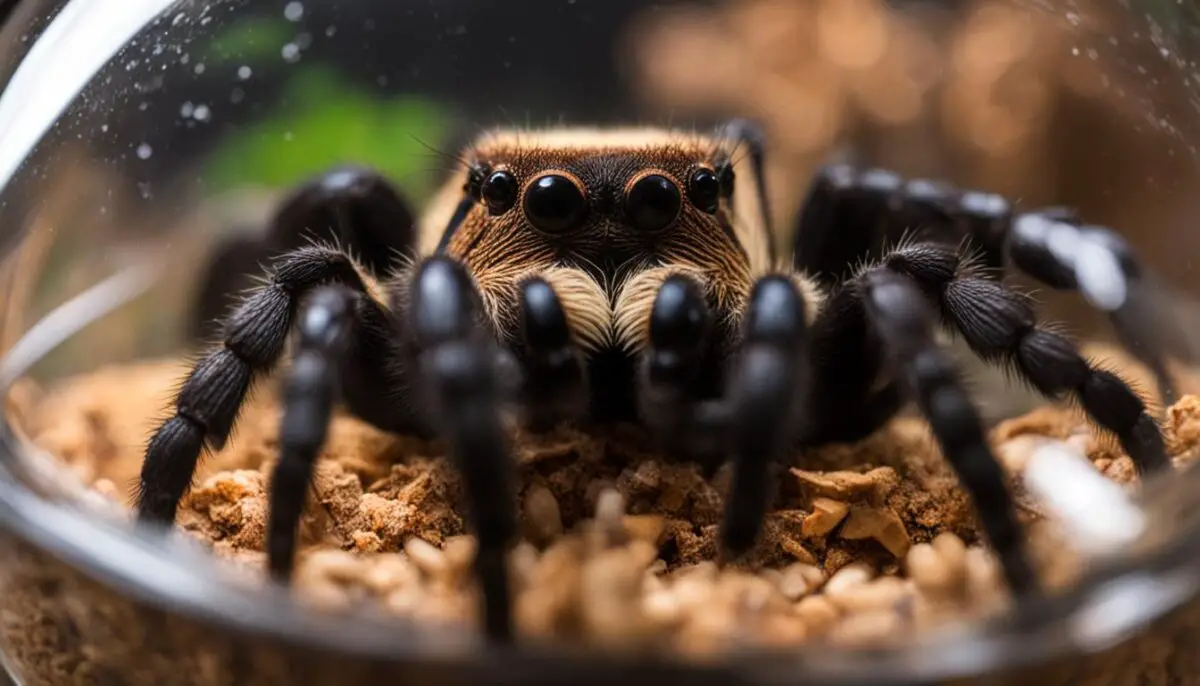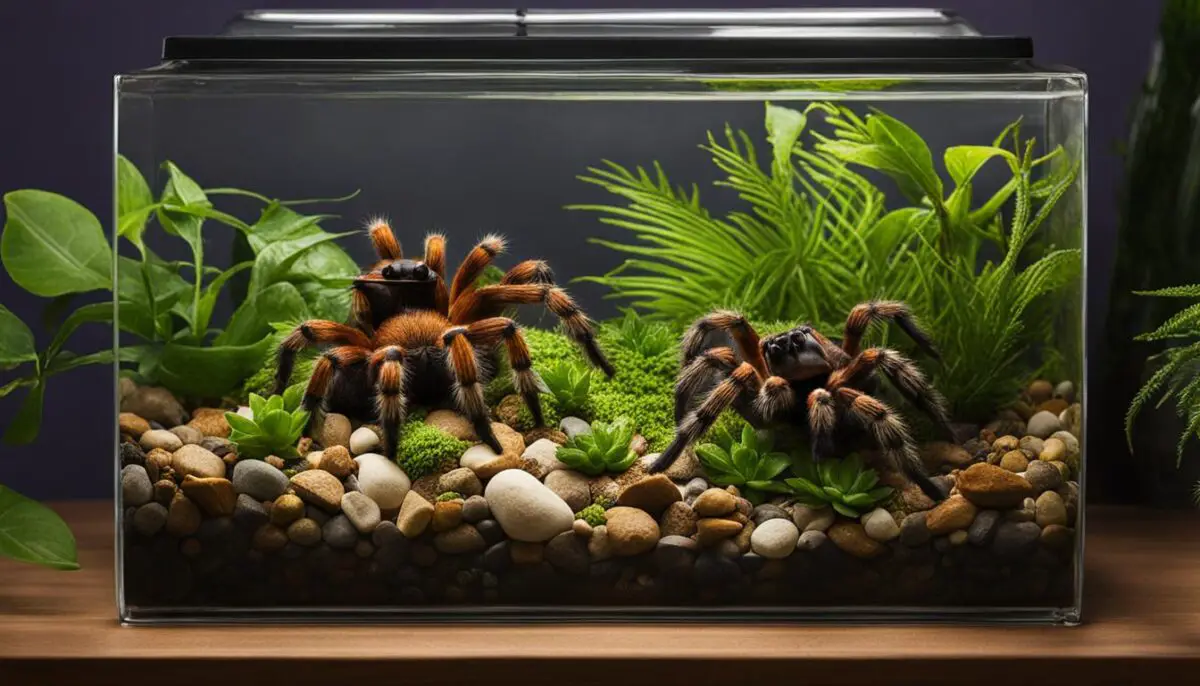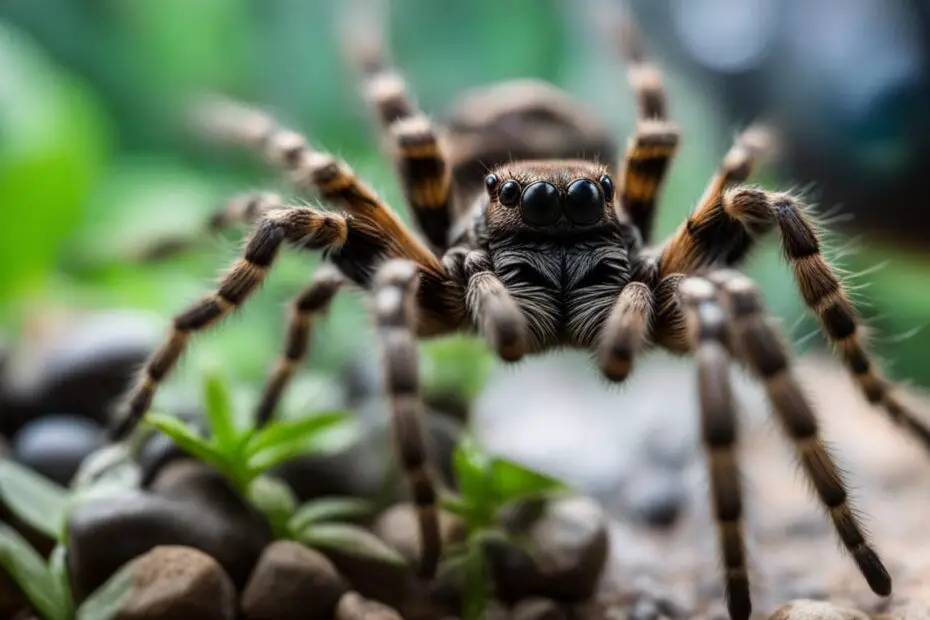Are you considering getting a pet? Have you ever thought about welcoming a tarantula into your home? While they may not be the first choice for many, tarantulas make excellent pets with numerous benefits. Let’s explore why tarantulas make good pets and discover the fascinating truth behind these captivating creatures.
Key Takeaways:
- Tarantulas are low-maintenance pets, requiring minimal care and space.
- There are over 900 species of tarantulas to choose from, offering a diverse range of colors, sizes, and behaviors.
- Tarantulas are inexpensive to keep, with minimal costs for enclosures and feeding.
- They have long lifespans, often living for 10 to 30+ years.
- Owning a tarantula can help people overcome arachnophobia and provide a sense of fascination and peace.
Why Tarantulas Make Good Pets
They Take Up Little Space
Tarantulas require very little space compared to other animals, making them suitable for smaller living areas. Most fully grown tarantulas only need an enclosure the size of a 5-10 gallon aquarium. They can be kept on shelves, desks, dressers, or nightstands. Their small footprint also allows for the collection of multiple tarantula species, as they do not require much room individually.
For those looking to set up a tarantula pet habitat, it is important to choose the right size enclosure. The size of the enclosure will depend on the species and the age of the tarantula. A juvenile tarantula can be kept in a smaller enclosure and then moved to a larger one as it grows. It is also essential to provide proper ventilation and secure the enclosure to prevent escapes. tarantulas as pets
When setting up the tarantula’s habitat, it is important to create a safe and comfortable environment. This can include providing hiding spots, such as cork bark or artificial plants, to mimic their natural habitats. It is also crucial to maintain the appropriate temperature and humidity levels for the specific species of tarantula.
They Take Up Little Space
| Enclosure Size | Recommended Location |
|---|---|
| 5-10 gallon aquarium | Shelves, desks, dressers, or nightstands |
There Are Many Tarantula Species to Choose From
Tarantulas are fascinating creatures that come in a wide variety of species, each with its own unique characteristics. From vibrant colors to different sizes and patterns, tarantulas offer a diverse selection for those interested in keeping them as pets. Here are some of the most popular tarantula species: benefits of keeping tarantulas as pets
- Grammostola rosea: Also known as the Chilean Rose Hair tarantula, this species is one of the most common and docile tarantulas, making it a popular choice for beginners.
- Brachypelma smithi: Also called the Mexican Red Knee, this species is known for its striking black and orange coloration and its docile temperament.
- Aphonopelma chalcodes: Commonly known as the Desert Blonde tarantula, this species is native to the southwestern United States and is prized for its calm and hardy nature.
- Avicularia avicularia: The Pink Toe tarantula gets its name from the pink tips on its legs. It is an arboreal species known for its agility and stunning appearance.
- Poecilotheria metallica: Referred to as the Gooty Sapphire Ornamental, this species is highly sought after for its metallic blue coloration and intricate patterns.
These are just a few examples of the many tarantula species available to pet owners. Each species has its own care requirements and unique behaviors, allowing enthusiasts to choose a tarantula that matches their preferences and interests.
Table: Popular Tarantula Species
| Species | Common Name | Characteristics |
|---|---|---|
| Grammostola rosea | Chilean Rose Hair | Docile, common, vibrant colors |
| Brachypelma smithi | Mexican Red Knee | Striking coloration, docile temperament |
| Aphonopelma chalcodes | Desert Blonde | Calm, hardy, native to southwestern US |
| Avicularia avicularia | Pink Toe | Arboreal, agile, pink-tipped legs |
| Poecilotheria metallica | Gooty Sapphire Ornamental | Metallic blue coloration, intricate patterns |
When selecting a tarantula, it’s important to research the specific needs and characteristics of the chosen species to ensure proper care and compatibility with your lifestyle. pet tarantula care
They Are Very Low Maintenance
Tarantulas are incredibly low-maintenance pets, making them an ideal choice for those who prefer a hands-off approach. Unlike other pets that require constant attention and care, tarantulas thrive with minimal maintenance. Here are some tarantula pet care tips to keep in mind: reasons to own a pet tarantula
- Feeding: Tarantulas only need to be fed once a week or even once a month, depending on their size and species. They primarily eat live insects such as crickets and cockroaches. It’s important to provide them with an appropriately sized meal to ensure their nutritional needs are met.
- Enclosure Cleaning: Tarantulas are clean animals and do not require frequent cleaning of their enclosure. Once they settle into their adult home, they can be kept on the same bedding for years with minimal care. Occasional spot cleaning is all that’s necessary to maintain their habitat.
- Hydration: Tarantulas require access to fresh water, but they don’t need to be watered as frequently as other pets. Providing a small dish of water in their enclosure is usually sufficient.
- Handling: While tarantulas can be handled, it’s important to remember that they are delicate creatures. Handling should be kept to a minimum and done with caution to avoid injuring the spider.
By following these simple tarantula pet care tips, you can ensure that your eight-legged friend remains healthy and happy with minimal effort on your part. Tarantulas are truly the perfect low-maintenance pets for those who appreciate their unique beauty and behaviors.

They Are Inexpensive to Keep
Tarantulas are not only fascinating pets, but they are also incredibly budget-friendly. From their enclosures to their food, the costs associated with keeping a tarantula are minimal compared to many other pets. Let’s break down the affordability of owning a tarantula: tarantula pet species
Enclosures
When it comes to housing your tarantula, you don’t need to invest in expensive setups. Many owners successfully keep their spiders in affordable plastic containers or simple glass tanks. These options provide ample space for your tarantula while keeping costs low.
Feeding
Feeding your tarantula is both simple and affordable. Tarantulas primarily eat live insects like crickets and cockroaches, which can be easily purchased in bulk. These insects are inexpensive and readily available at most pet stores. Compared to the cost of feeding larger pets, such as dogs or cats, the food expenses for tarantulas are significantly lower.
Purchase Cost
When it comes to acquiring a tarantula, they can be fairly inexpensive, especially if you opt for spiderlings (young tarantulas). Spiderlings are often more affordable than adult tarantulas, allowing you to start your collection without breaking the bank. Additionally, the wide variety of tarantula species means there are options available at various price points to suit different budgets.
| Expense | Cost |
|---|---|
| Enclosure | Affordable plastic container or glass tank |
| Food | Inexpensive live insects |
| Purchase Cost | Affordable, especially for spiderlings |
As you can see, owning a tarantula is quite affordable, making them an excellent pet choice for those on a budget. Their low-cost requirements for enclosures, food, and initial purchase make tarantulas an accessible pet option for many individuals. tarantula pet setup
Setting up Their Habitats Can Be Quite Rewarding
Creating a suitable and visually appealing habitat for your pet tarantula can be an enjoyable and rewarding experience. While it is not necessary for the well-being of the tarantula, many owners take pleasure in designing beautiful and naturalistic enclosures that mimic the spider’s natural habitat. These setups can serve as a captivating centerpiece and add a touch of nature to any room.
Consider using a premium glass or acrylic enclosure and incorporate live plants, moss, and leaf litter to create a more authentic environment. These elements not only enhance the aesthetic appeal of the enclosure but also provide hiding spots and stimulation for the tarantula. It is important to research the specific habitat requirements of the tarantula species you choose to ensure you create the ideal living space for them.

“Creating visually-appealing homes for tarantulas can be a rewarding aspect of the hobby.” – Tarantula enthusiast
Table: Ideal Tarantula Habitat Setup
| Enclosure Size | Temperature | Humidity | Substrate |
|---|---|---|---|
| 5-10 Gallon Aquarium | 70-80°F (21-27°C) | Varies by species (research required) | Peat moss, coco fiber, or a mixture |
When setting up the habitat, it’s crucial to ensure proper ventilation to avoid excessive humidity and mold growth. Ventilation can be achieved by using a mesh lid or air vents on the sides of the enclosure. Additionally, make sure to provide a secure lid or closure system to prevent escapes. choosing a pet tarantula
Remember to regularly monitor temperature and humidity levels within the enclosure and make adjustments as needed. A hygrometer and thermometer can be invaluable tools for maintaining the ideal conditions for your tarantula’s well-being.
- Research your tarantula species for specific habitat requirements
- Incorporate live plants, moss, and leaf litter for a natural look
- Ensure proper ventilation to avoid excessive humidity
- Monitor temperature and humidity levels regularly
Setting up the perfect habitat for your tarantula not only ensures their comfort and well-being but also provides a visually pleasing and engaging space for you to enjoy. It allows you to connect with nature and appreciate the beauty and uniqueness of these fascinating creatures. pet tarantula handling
Tarantula Lifespan: Long-Term Companionship
When considering a pet, longevity is an important factor to take into account. Tarantulas, particularly females, have impressively long lifespans ranging from 10 to 30+ years, depending on the species. This means that owning a tarantula can be a long-term commitment, providing companionship for many years to come. Even male tarantulas, which typically have shorter lifespans, can live for 5 years or longer. This extended lifespan makes tarantulas an excellent choice for individuals looking for a pet that will be around for a significant portion of their life.
Unlike other pets that may have shorter lifespans, tarantulas offer the opportunity to form a long-lasting bond and create lasting memories. Watching your pet tarantula grow and thrive over the years can be a rewarding and fulfilling experience. It’s important to note that the lifespan of a tarantula can vary depending on various factors, such as species, care, and environmental conditions. Providing the proper care and a suitable environment can help ensure that your tarantula enjoys a long and healthy life.
Potential Lifespan Comparison
To give a clearer perspective on tarantula lifespan, here is a comparison with the average lifespans of some other popular pets:
| Pet | Average Lifespan |
|---|---|
| Tarantula | 10 to 30+ years |
| Dog | 10 to 13 years |
| Cat | 12 to 16 years |
| Gerbil | 2 to 4 years |
| Hamster | 2 to 3 years |
As you can see, tarantulas can potentially live significantly longer than many other commonly kept pets, providing a unique opportunity for a long-term pet relationship.

One aspect that makes tarantulas a unique tool for overcoming arachnophobia is their relatively docile nature. Tarantulas are generally slow-moving and non-aggressive, making them less intimidating than other types of spiders. Their calm demeanor and lack of interest in biting or attacking humans help to create a sense of safety and trust for those who are fearful of spiders.
“My fear of spiders was debilitating and affecting my daily life. But when I started caring for a tarantula, something clicked. I realized that these creatures aren’t out to get me, they’re just trying to live their lives. It was a turning point for me, and now I can appreciate spiders in a whole new light.” – Jane, former arachnophobia sufferer
In addition to their gentle nature, tarantulas offer a unique opportunity for education and understanding. By learning about their natural habitat, behavior, and unique characteristics, individuals can gain a deeper appreciation for the role they play in the ecosystem. This newfound knowledge can help dispel common misconceptions about spiders and foster a sense of fascination and wonder.
Benefits of Tarantulas in Overcoming Arachnophobia:
- Relatively docile nature compared to other spiders
- Create a sense of safety and trust
- Opportunity for education and understanding
- Dispelling common misconceptions about spiders
- Fostering a sense of fascination and wonder
Overall, owning a pet tarantula can be a transformative experience for those struggling with arachnophobia. These incredible creatures offer a unique opportunity for personal growth, allowing individuals to conquer their fears and develop a newfound appreciation for the natural world around them.
Tarantulas Are Good for Mental Health
Caring for tarantulas can have a positive impact on mental health. The meditative nature of tending to these creatures can provide a sense of calm and relaxation. Many owners report that interacting with their tarantulas helps them reduce stress, manage anxiety and depression, and find a sense of peace.
The process of caring for tarantulas can be a therapeutic activity that promotes well-being and provides a unique form of companionship. It allows individuals to focus their attention on something outside of themselves and their own worries, creating a sense of mindfulness and distraction from negative thoughts and feelings. The rhythmic tasks of feeding, cleaning, and observing tarantulas can offer a sense of purpose and routine, which is essential for maintaining mental well-being.
Quotes from Tarantula Owners
“When I’m feeling overwhelmed, spending time with my tarantulas helps me relax and regain my focus. It’s like therapy, but with eight-legged companions!” – Sarah, tarantula owner
“I suffer from anxiety, and caring for my tarantulas has been incredibly helpful in managing it. They bring a sense of peace and tranquility into my life.” – Alex, tarantula owner
Overall, tarantulas offer a unique and fulfilling pet ownership experience. Beyond their fascinating beauty and behaviors, they can positively impact mental health by providing a calming presence and promoting a sense of well-being. Whether it’s the rhythmic routine of caring for them or the sense of connection and fascination they inspire, tarantulas can be a therapeutic addition to anyone’s life.

Conclusion
Tarantulas make excellent pets for a variety of reasons. They are low-maintenance, take up little space, and offer a wide variety of species to choose from. Tarantulas are also inexpensive to keep, have long lifespans, and can help individuals overcome their fear of spiders. Additionally, caring for tarantulas can have a positive impact on mental health, providing a sense of calm and fascination.
Overall, tarantulas are fascinating creatures that can make great pets for those willing to embrace their unique beauty and behaviors. Whether you’re looking for a low-maintenance pet that won’t take up much space or hoping to overcome your fear of spiders, tarantulas offer a rewarding and captivating experience. So, consider bringing one of these incredible arachnids into your life and discover the joys of tarantula ownership.
FAQ
Why are tarantulas considered good pets?
Tarantulas make excellent pets because they are low-maintenance, take up little space, and offer a wide variety of species to choose from. They are fascinating creatures that can provide a sense of fascination and peace.
How much space do tarantulas require?
Most fully grown tarantulas only need an enclosure the size of a 5-10 gallon aquarium. They can be kept on shelves, desks, dressers, or nightstands, making them suitable for smaller living areas.
How many species of tarantulas are there?
There are over 900 species of tarantulas to choose from, offering a wide range of colors, sizes, and behaviors. This diversity allows for a diverse and interesting choice when selecting a pet tarantula.
How much care do tarantulas require?
Tarantulas are incredibly low-maintenance pets. They only need to be fed an appropriately sized meal once a week or even once a month. They are clean animals and do not require frequent bedding or substrate changes.
Are tarantulas expensive to keep?
Tarantulas are one of the least expensive pets to maintain. They do not require costly enclosures or heating elements. The food costs for tarantulas are also minimal, as they primarily eat live insects. Additionally, the spiders themselves can be fairly inexpensive, especially when purchased as spiderlings.
Can I create a visually-appealing enclosure for my tarantula?
While not necessary for the tarantula’s well-being, many owners enjoy creating beautiful and naturalistic enclosures for their pets. Premium glass or acrylic enclosures with live plants, moss, and leaf litter can add a touch of nature to any room.
How long do tarantulas live?
Female tarantulas, in particular, have long lifespans ranging from 10 to 30+ years, depending on the species. Even males, which have shorter lifespans, can live for 5 years or longer. Tarantulas can be a long-term commitment, providing companionship for many years.
Can owning a tarantula help with arachnophobia?
Interestingly, owning a pet tarantula can help people overcome their fear of spiders. The experience of caring for these misunderstood creatures and understanding their behavior helps to dispel common misconceptions and create a sense of fascination and appreciation.
Can caring for tarantulas have a positive impact on mental health?
Yes, caring for tarantulas has been shown to have a positive impact on mental health. The low maintenance and meditative nature of tending to these creatures can provide a sense of calm and relaxation. Many owners report that interacting with their tarantulas helps them to reduce stress, manage anxiety and depression, and find a sense of peace.
Are tarantulas good pets overall?
Tarantulas make excellent pets for a variety of reasons. They are low-maintenance, take up little space, offer a wide variety of species to choose from, and can help individuals overcome their fear of spiders. Furthermore, caring for tarantulas can have a positive impact on mental health, providing a sense of calm and fascination.


Valuable information. Lucky me I found your website by accident, and I’m shocked why this accident didn’t happened earlier! I bookmarked it.
This web site is really a walk-through for all of the info you wanted about this and didn’t know who to ask. Glimpse here, and you’ll definitely discover it.
hey there and thank you for your information – I have certainly
picked up anything new from right here. I did however expertise a few
technical points using this web site, as I experienced to reload the site a lot of times previous to I could get it
to load properly. I had been wondering if your hosting is OK?
Not that I am complaining, but sluggish loading instances times will sometimes affect your
placement in google and can damage your high quality score if ads and marketing with Adwords.
Well I am adding this RSS to my e-mail and could look out for a lot more of your
respective intriguing content. Make sure you update this again soon..
Lista escape room
I was examining some of your blog posts on this website and
I think this website is rattling informative! Retain posting.?
Great article! We will be linking to this great content on our website. Keep up the great writing.
Howdy! This blog post could not be written any better! Looking through this article reminds me of my previous roommate! He constantly kept preaching about this. I am going to forward this information to him. Pretty sure he’s going to have a good read. I appreciate you for sharing!
An impressive share! I’ve just forwarded this onto a colleague who has been conducting a little research on this. And he in fact bought me lunch because I discovered it for him… lol. So allow me to reword this…. Thanks for the meal!! But yeah, thanx for spending time to discuss this topic here on your web site.
I’m impressed, I have to admit. Seldom do I come across a blog that’s both equally educative and entertaining, and let me tell you, you’ve hit the nail on the head. The problem is something that too few folks are speaking intelligently about. Now i’m very happy that I stumbled across this during my hunt for something relating to this.
Spot on with this write-up, I seriously think this web site needs a lot more attention. I’ll probably be returning to read through more, thanks for the info.
Everything is very open with a very clear clarification of the challenges. It was truly informative. Your site is useful. Thanks for sharing!
Greetings! Very useful advice within this article! It is the little changes which will make the largest changes. Many thanks for sharing!
Spot on with this write-up, I really believe this site needs much more attention. I’ll probably be returning to read more, thanks for the info.
I truly love your site.. Great colors & theme. Did you create this site yourself? Please reply back as I’m wanting to create my own personal site and would like to learn where you got this from or just what the theme is named. Kudos!
I’m impressed, I have to admit. Rarely do I encounter a blog that’s both educative and amusing, and let me tell you, you have hit the nail on the head. The problem is something too few men and women are speaking intelligently about. I am very happy that I found this during my search for something concerning this.
You’ve made some decent points there. I checked on the internet for more info about the issue and found most people will go along with your views on this web site.
You’re so awesome! I don’t think I’ve truly read anything like this before. So good to find someone with some original thoughts on this subject. Really.. thank you for starting this up. This site is something that’s needed on the internet, someone with a bit of originality.